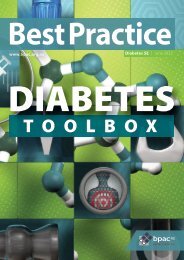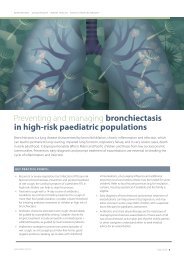Create successful ePaper yourself
Turn your PDF publications into a flip-book with our unique Google optimized e-Paper software.
The line between normotension and hypertension is therefore<br />
arbitrary, and patients should be encouraged to make lifestyle<br />
adjustments to control or reduce their BP before they are<br />
diagnosed with hypertension.<br />
Hypertension in New Zealand<br />
In New Zealand, the mean systolic BP of many people is<br />
increasing due to the rise in obesity, sedentary lifestyles and<br />
the increasingly high fat, sugar and salt content of food. 5<br />
Hypertension is often under-treated; Māori, Pacific and Asian<br />
peoples with hypertension have lower rates of antihypertensive<br />
use compared with Europeans (Figure 1). 6 Even though not all<br />
patients with hypertension require antihypertensive medicines<br />
– and lifestyle modifications may be sufficient for some patients<br />
– these disparities need to be recognised and addressed across<br />
primary care.<br />
Diagnosing hypertension<br />
Most cases of hypertension are asymptomatic, and treatment<br />
often involves lifelong exposure to multiple medicines and<br />
their potential adverse effects. 1 Therefore, it is essential that<br />
hypertension is accurately diagnosed in primary care.<br />
If the clinic BP is ≥130/90 mmHg a clinical evaluation should<br />
be conducted in order to:<br />
1. Confirm the elevated BP<br />
2. Assess the CVD risk of the patient<br />
3. Determine if any end organ damage has occurred<br />
4. Detect any causes of secondary hypertension<br />
1. Confirming elevated BP<br />
To achieve a more accurate assessment it is recommended that<br />
at least two BP measurements be taken, at least two minutes<br />
apart. Ideally, an additional measurement should also be<br />
taken in the patient’s other arm in case there is a significant<br />
difference. 1 Consistent systolic BP differences >10 mmHg are<br />
associated with an increased risk of CVD. 1 If BP measurements<br />
are elevated at a single appointment, another reading should<br />
be taken at a separate appointment on a different day to<br />
confirm a diagnosis of hypertension. 1<br />
Clinic readings do not always reflect the true BP despite the<br />
use of appropriate measurement procedures, due to patientspecific<br />
psychological, physiological and behavioural factors. 1<br />
On average, measurements are 5–10 mmHg higher in this<br />
setting compared with at-home or ambulatory monitoring. 1<br />
Therefore, 24-hour ambulatory monitoring (the“gold standard”)<br />
or at-home monitoring may be required to confirm a diagnosis<br />
of hypertension and to rule out:<br />
White-coat hypertension if measurements are<br />
consistently elevated despite the absence of obvious risk<br />
factors<br />
Masked hypertension if office BP is consistently<br />
normal but there are clinical features consistent with<br />
hypertension, e.g. signs of end-organ damage<br />
For further information on 24-hour ambulatory or at-home<br />
monitoring, see: “Out-of-clinic BP testing in primary care”,<br />
https://bpac.org.nz/BPJ/2016/May/blood-pressure.aspx<br />
Prevalence of hypertension Antihypertensive use % untreated<br />
Total 21.6% 16.1% 25.5%<br />
Maori 22.5% 13.5%<br />
40.0%<br />
Pacific 21.2% 13.4%<br />
36.8%<br />
Asian 15% 9.2%<br />
38.7%<br />
European/Other 22.4% 17.1% 23.7%<br />
Figure 1. Prevalence of hypertension versus rates of antihypertensive use in New Zealand by ethnicity, 2018. 6<br />
www.bpac.org.nz<br />
Best Practice Journal – SCE Issue 1 19









